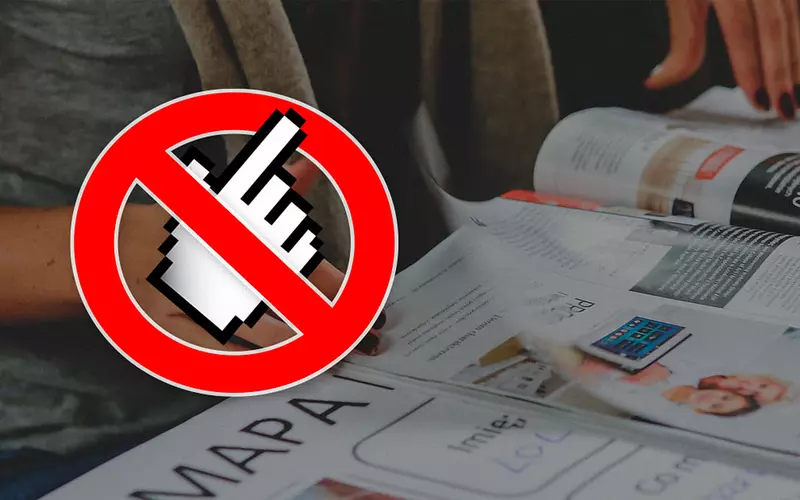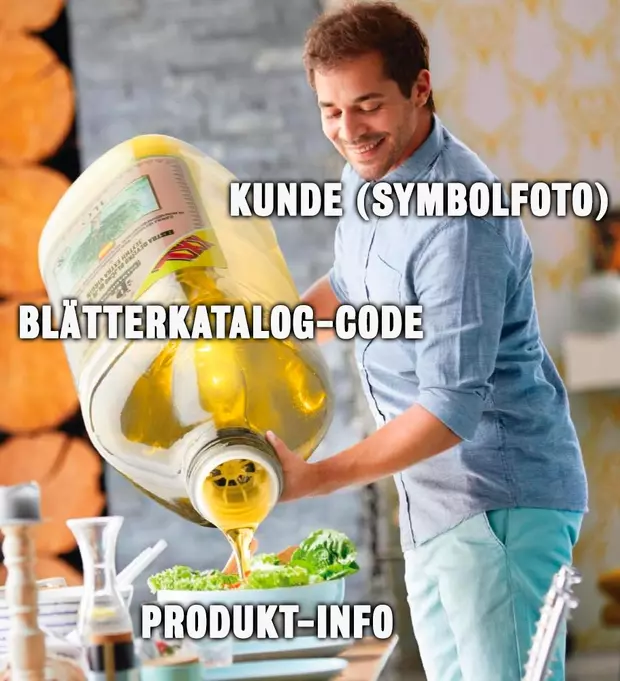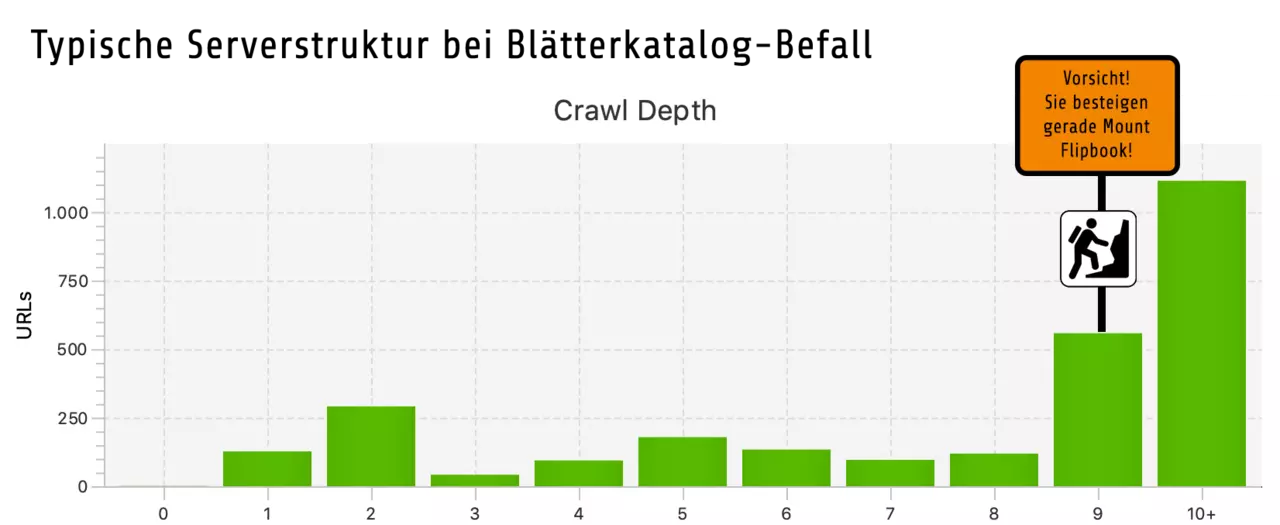
The destruction of flip page catalogs

A short long rant against "flipbook"-based product presentations on the web
Flip catalogs are to digital agencies what globules are to pharmacies: From a technical (evidence-based!) point of view, they are considered completely useless - but customers still want to fulfill their expensive wishes, of course.
But why are retailers and manufacturers still so fervently attached to the flip page catalog - to a dinosaur form of presentation that has actually become completely superfluous on the modern web?
A look back: The rise of flip page catalogs - or "How did this happen?"
In the founding days of the internet (older readers will remember), the idea was to use analog metaphors to pick up inexperienced users into the brave new cyber world. A flip page catalog seemed particularly appropriate for presenting products. Here, for example, is a quote from a not-so-fresh contemporary usability article (editor's note: the article originally linked here no longer exists):
"Generations of users, young and old, are familiar with catalogs. Their structure and content logic have been internalized. We have learned - so to speak - to read catalogs. There is the picture - here the price and there the sizes - turning the page to other offers is done just as quickly"
The basic assumption, however, is that users do not want to conduct targeted research, but rather browse through the offerings at their leisure. If they are looking for something, it is only for inspiration.
This is how the flip page catalog fan imagines the typical usage situation (yesterday as today)
A wide range of page-turning catalog programs
After the first multimedia flip page catalogs (Flash!), more modern programs (just google Flipbook) and various SaaS service providers established themselves very quickly, converting PDF files in the blink of an eye into seemingly interactive catalog presentations for flipping through (only real with the original Page-Curl-Animation Effect™ - you can practically even hear the paper crackle!). The better - and also much more expensive - of these programs can even zoom in on individual page sections or link to a matching store page. There are even some rudimentary search functions to find the desired products faster.
All advantages? Especially for stressed friends of the print file
For many decision-makers, these features seemed very charming. Those who came from the print culture had usually invested an absurd amount of money and coordination effort in sophisticated layouts of catalogs and print brochures as prepress PDFs anyway. And this investment should now also pay off online! So the PDF is simply taken to derive the web presence from it. This also saves the effort of preparing data for databases or online product detail pages. It's much easier to browse through the catalog anyway! And another advantage for print-savvy clients: in the flip page catalogs, all the pixels are exactly where you want them.
In addition to these nice aspects of work reduction for overburdened project managers who want to do this online stuff "on the side" anyway, there are unfortunately also a number of nasty disadvantages.
Unpleasant side effects and disadvantages of flip page catalog application

Apart from the fact that not every user necessarily has the necessary leisure and patience to deal with the offers of the flip page catalog, here is an incomplete list of the major disadvantages of flip page catalogs.
- A flip page catalog is extremely slow. Each time it is called up, it pumps unbelievably large amounts of data (print catalog!) through the net. This is especially nice if you are still waiting behind a slow or expensive data connection, typical for Germany!
- Besides the sprawling image data, the generation of the catalog creates a huge overhead of additionally needed scripts and frameworks, which often don't fit to the rest of the tech stack of the normal websites. Of course, in case of doubt, these scripts never get the necessary security updates.
- Many flip page catalog programs are not yet sufficiently optimized for Responsive Web Design. The better providers often already create variants for the mobile version, but rarely are these adapted for all the now newly widespread devices and possible intermediate sizes.
- Poor search: flip catalog content is very poorly found by search engines (even with partial internal optimization). If the catalog is to be searched internally, the search indexes often have to be painstakingly entered afterwards. This work is better invested elsewhere!

Proven SEO side effects of the flip catalog
Another general problem of flip page catalogs concerns data structure and information architecture. The programs dump a huge muckheap of automatically generated detail pages somewhere on the server, which are often linked to from only a few individual pages and are therefore spidered around in extremely deep directory levels. (see Fig. 3).
The crucial question: Do flip page catalogs convert? Beyond the placebo effect?
Unfortunately, this question cannot really be definitively answered here. Because although this form of product presentation seems to be so immensely popular, especially in Germany, you can't find any easily accessible studies that can conclusively prove the effectiveness - or lack of effectiveness - of flip page catalogs in generating leads or selling products.
Or have I possibly only researched too superficially? If you know of suitable studies that can clearly prove the effectiveness of the flip page catalog, we will be happy to publish the links to these pages here.
Unfortunately, even companies that use flip page catalogs often lack the corresponding usage statistics, since catalog calls and link clicks to order pages or feedbacks are not meaningfully linked to events for the web analysis programs. However, based on our (admittedly not statistically representative) experience, we assume that the positive utility value of flip page catalogs tends towards zero.
We therefore recommend that, at least in the case of a relaunch, sufficient trackers are to be installed in every flip page catalog and that the actual added value of these offers be regularly put to the test.
Sensible alternatives to the flip page catalog
Can flip page catalogs simply be omitted? Yes, it is possible. Especially if you put some effort into the design of the normal product detail pages on the web server. Ideally, all relevant product data and media should be stored in a PIM-system (Product Information Management) and automatically fed into a customized content management system with machine-readable, structured data markup.
Well, admittedly, this is often not yet the case. But at least serious providers should be on their way to this ideal state by now.
For the transition, however, it should be enough to at least put all the important information that really interests the user and customer on the corresponding (search engine optimized) landing pages.
But if it's still a matter of distributing a feel-good catalog with wonderful atmospheric images for relaxation, you can simply offer the pretty print template for download as a normal PDF. Believe us: users really won't miss the page turning animations.
Conclusion / Wake-up call:
Online flip page catalogs have lost nothing in the modern web and urgently need to be replaced! Free view on product data! Down with the pagecurl!

I look forward to your agreement or counterarguments (gladly here in the comments).
First reactions:
You have completely forgotten the aspect of costs. Whereas you can distribute structured data with little effort, PDFs have to be converted extensively. There also costs more server resources and power.
- Daniel Siepmann (@daniel_siepmann) July 26, 2019
Imho, flip page catalogs already have a raison d'être. With little effort, they pick up the customer where he unfortunately often still stands: With the print catalog. Compared to PDF, some versions also offer good loading behavior through reloading and you can quickly get away from the PDF pixel mush.
— Veit Rumpf (@VRumpf) July 26, 2019
Please feel free to share this article.
Comments
No comments yet.